Orchard Notes: July 2020
Worker Safety at Harvest
[View CDFA Recommendations]
CFAP Grower Payments
Earlier this month, USDA announced a list of additional commodities eligible for direct payments for losses due to supply chain and market impacts resulting from COVID-19 between mid-January and April 15. The California Prune Board provided comments to the federal registrar to make the case for why prunes should be included based on our case that a 5% or greater price reduction – a criterion for consideration – had occurred in the 3-month period as a result of the virus.
While prunes did not make the list in USDA’s latest announcement, along with other notable commodities such as walnuts and raisins, most of the products that were listed were directly impacted by the interruption in foodservice and were overlooked initially because data was unavailable in the sources used by USDA. The California Prune Board remains in communication with officials to ensure our request is given serious consideration and we will continue to keep you updated about future announcements as they are made.
[Stay Informed About Financial Relief Updates]
Listening Sessions
Tuesday, Aug. 4 at Noon
Tuesday, Aug. 4 at 4 p.m.
HANDLER LISTENING SESSION
Thursday, Aug. 6 at 10 a.m.
[Register Now]
California Prune Board Election Results
[Read the Announcement]
In Case You Missed It: Pruning Prunes Zoom Discussion
[Find the Recording Here]
Pre-Harvest & Harvest Prune Orchard Considerations
Franz Niederholzer, UCCE Farm Advisor; Colusa and Sutter/Yuba Counties
Katherine Jarvis-Shean, UCCE Orchard Advisor; Yolo, Solano, & Sacramento Counties
July
- Start anticipating harvest timing. The UC prune harvest prediction model anticipates harvest in the Sacramento Valley starting roughly in the last week of August or perhaps the first days of September, based on regional bloom dates and CIMIS weather station data. The exact date will vary from block to block. With a lighter crop in many orchards, fruit may reach harvest maturity a week or so ahead of the timing predicted by the UC model. Bottom line; indications are that harvest will be in the second half, not the first half, of August in many prune growing areas. Once the first healthy fruit in the orchard start changing color along the suture (see photo below), fruit should be ready to harvest in roughly 30 days. For more on harvest timing, see the article in this newsletter.
- Collect leaf samples to gauge what nutrients are sufficient, deficient and perhaps over-supplied. Adjust the rest of the year’s nutrient management program and next year’s nutrient plan accordingly. Collect from at least 25 trees, gathering 1-2 leaves per tree from non-bearing spurs. A table listing critical levels of essential nutrients in prune appears after this article.
- Brown rot treatment, where deemed necessary based on observations and block history, begin sprays 4-6 weeks before harvest. These preventative sprays are only useful on uninjured fruit. Check with your processor regarding fungicides that are approved for use. The European Union (EU) has banned propiconazole (Tilt®, Bumper®, etc.) use in the EU. For more on fruit brown rot, see com/prunes/fruit-brown-rot/.
- Apply 20% of your total nitrogen budget in June or July to match the timing of tree demand. Lower rates in June may be prudent if you have a history of hard-to-manage brown rot. See cdfa.ca.gov/fertilizerresearch/docs/Prune_Plum.html for more on rate and timing of nitrogen applications.
August
- Time your irrigation cut-off to improve dry-away ratios, reduce premature fruit drop and decrease shaker bark damage at harvest. The sweet spot for irrigation cutoff timing varies by soil type. The pressure chamber is a great irrigation management tool for monitoring tree water stress. July and August, prior to harvest, stress should be mild to moderate (-12 to -16 bars). Moderate to high tree stress (-16 to -20 bars) may be tolerated a week or two before harvest. Read more on both pre- and post-harvest irrigation decisions in the article in this newsletter.
- Monitor fruit maturity development (see harvest prep article in this newsletter).
- Field sizing decisions. Many growers regularly run a 15/16th sizer to remove garbage and undersized fruit. This year, fewer orchards than last this year might benefit from a larger sizer, but the process of checking dry fruit size and deciding on a sizer is important every year (see harvest prep article in this newsletter).
- Clean up the orchard before harvest. Remove dead and dying limbs along with significant (woody) suckers. This will help minimize tree damage during shaking and make for a more efficient harvest.
- Examine fruit pre-harvest to evaluate damage. Two to four weeks before harvest, evaluate 40 fruit per tree from 25 trees throughout the orchard for worm, scale, and brown rot damage. Fruit can be picked or evaluated on the tree. If you just take samples at harvest, you may miss damaged fruit that dropped early that may indicate room for improvement in to your IPM program. An evaluation form is available at: ucanr.edu/PMG/C606/prune-fruitdamagesample.pdf
- Manage post-harvest irrigation to minimize water stress. Following harvest, water stress measured as stem water potential using a pressure chamber should be mild to moderate (-12 to -16 bars).
Post-Harvest
- Fall nutrition program. When making fall nutrient management decisions consider your July leaf sample results and crop load. If nitrogen levels in your July leaf sample were below the critical value, consider a fall foliar nitrogen spray, especially in young orchards where low nitrogen can predispose the trees to bacterial canker infection over a wet winter. Soil applied nitrogen, especially after September, is vulnerable to leaching because of limited root activity. Soil applied potassium (K) should be banded in the fall.
- Orchard clean up and pruning. Plan for pruning to remove Cytospora cankers, cut out branches damaged during harvest, tame tree size, and manage next year’s crop load. To make sure you’re cutting all infected wood from the tree, see photos of a “clean” pruning at com/prunes/pruners-pocket-guide-for-cutting-out-cytospora. Avoid pruning two weeks prior to a rain event. Consider protecting pruning wounds, especially if rain is in the forecast with a fungicide spray (e.g. Topsin-M® or Topsin-M + Rally®).
- Fall/winter aphid control. Fall and winter preventative management for aphids can be an effective and ideal time to treat orchards with a history of problems, particularly if no dormant sprays will be applied for scale or peach twig borer. Fall aphid sprays are not effective for scale and don’t provide the same level of control as dormant timings for peach twig borer During the dormant period, a moderate rate of pyrethroid is effective on aphids andpeach twig borer, but keep in mind water quality risks when timing dormant pyrethroid applications. Adding oil to a dormant pyrethroid treatment can provide additional efficacy against moderate-sized scale populations. For additional detail, see articles on prune aphid management at: sacvalleyorchards.com/prunes/
- San Jose Scale. Dormant spur samples can be used to scout for San Jose scale and European fruit lecanium, evidence of parasitism in both species, as well as aphid eggs and European red mite eggs in this sample. More information on dormant sampling and treatment thresholds ucanr.edu/PMG/r606900511.html.
- Weed Management. Conduct a post-harvest weed survey (ucanr.edu/PMG/C606/prune-fallweeds.pdf) to evaluate your 2020 weed control program. Pre-emergent herbicide should be applied shortly before a moderate rain event (0.25”) to move material into the soil. Avoid application prior to a large rain event (> 1”), which can move the product too deep into the soil for good weed control.
- Late fall to early winter is prime gopher control timing because populations are generally lowest at this time of year. See gopher control strategies at: ipm.ucanr.edu/PMG/r105600211.html
Critical Nutrient Levels for Prune Leaves* Sampled in July
| Nutrient | Critical Levels |
| Nitrogen | Below 2.2% = deficient
2.3-2.8% = adequate |
| Phosphorous | 0.1-0.3% = adequate |
| Potassium | Under 1.0% = deficient
1.3-2.0% = adequate Over 2.0% = excessive (not toxic, but no need to fertilize) |
| Calcium | Over 1.0% = adequate |
| Magnesium | Over 0.25% = adequate |
| Sodium | Over 0.2% = excessive (potentially toxic) |
| Chloride | Over 0.3% = excessive
(potentially toxic) |
| Boron | Under 25 ppm = deficient
From 25-80 ppm = adequate Over 100 ppm = excessive (potentially toxic) |
| Copper | Over 4 ppm = adequate |
| Manganese | Over 20 ppm = adequate |
| Zinc | Under 18 ppm deficient |
*Fully expanded leaves from non-bearing spurs sampled in July.
Pre- and Post-Harvest Irrigation Management in Prunes
Luke Milliron, UCCE Orchards Advisor, Butte, Glenn, and Tehama Counties
Franz Niederholzer, UCCE Farm Advisor; Colusa and Sutter/Yuba Counties
Allan Fulton, UCCE Irrigation and Water Resources Farm Advisor Emeritus
Richard Buchner, UCCE Farm Advisor Emeritus
Irrigation decisions leading up to and following prune harvest not only impact this year but also the harvests and orchard health in the years to come. Shoot growth has been in decline since early June, fresh fruit size increase slows by the end of July, while fruit dry weight increases until fruit reach physiological maturity (4 lbs pressure). Floral and vegetative bud development, for next year’s crop is also occurring, beginning in June and July on the current season’s growth, see Figure 1. Average monthly evapotranspiration (ET) and the gradual seasonal ET accumulation are also given in the figure.
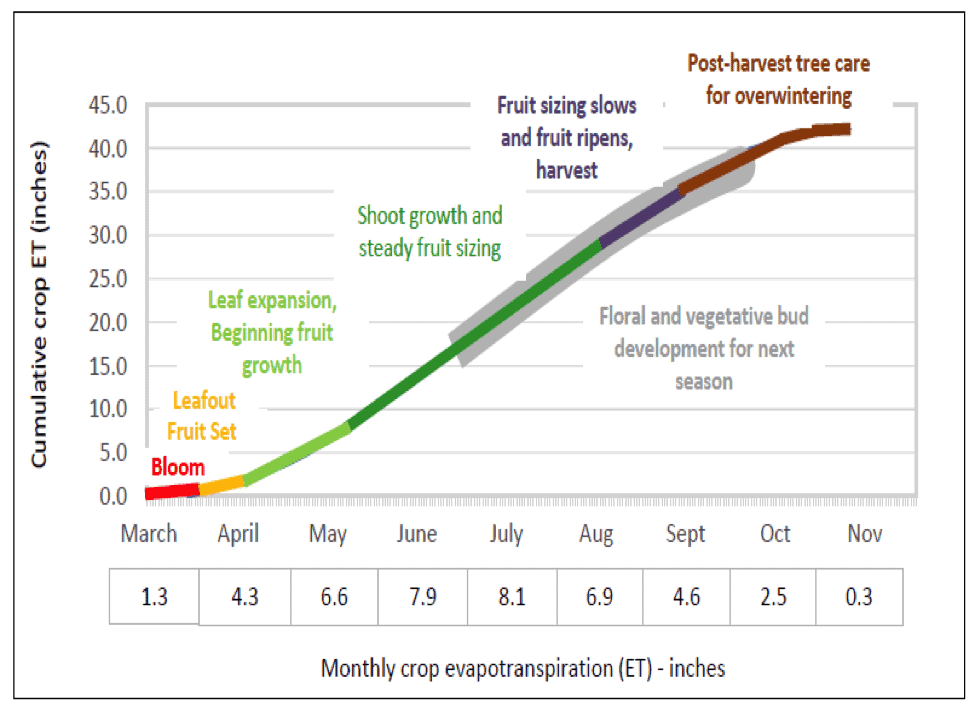
Figure 1. Graphic timeline of prune tree and crop development phases and associated average monthly and cumulative crop evapotranspiration (ET).
Like other crops, prune has varying susceptibility to water stress at different crop development stages. Deficit irrigation or supplying the trees with less than full ET (Figure 1), can offer key benefits beyond water savings and reduced pumping cots. To avoid excessive vegetative growth and associated pruning costs, maintaining a mild to moderate tree water stress from late June, through early August reduces shoot growth without slowing fruit sizing (Table 1). Once fruit have reached physiological maturity (4 lbs fruit pressure), a moderate to high stress achieved by cutting off irrigation in the week or two before harvest can improve dry-away ratios, reduce premature fruit drop, and decrease shaker bark injury at harvest. Post-harvest irrigation should recover the trees to mild- to moderate-stress in-order to not reduce photosynthesis and disrupt carbohydrate allocation to storage leading into overwintering. Care must be taken with any irrigation reductions. Sustaining high to severe water stress during the pre- and post-harvest period can reduce potassium uptake, encourage sunburn and growth of Cytospora cankers, and result in smaller fruit buds the following year.
Irrigation Management Approaches:
Although ET calculations or soil moisture monitoring can be used to manage irrigation surrounding harvest, they do not directly measure the water status of the tree. Conversely, pressure chamber stem water potential (SWP) readings do directly measure tree water status and can be used to help deliver the beneficial stress timings and avoid unwanted severe stress. SWP readings of -12 to -16 bars from late June up to the preharvest irrigation cut-off and again after harvest, achieve the desired mild to moderate stress level without harm to the orchard (Table 1). Cutting off irrigation in the week or two before harvest to achieve -16 to -20 bars SWP, delivers the desired moderate to high stress that helps reduce dry away and trunk damage (“barking”) at harvest. Finally, triggering irrigations according to SWP readings allows you to avoid unwanted crop stress levels, especially below -20 bars. To learn more about using and interpreting pressure chamber SWP readings, see: sacvalleyorchards.com/manuals/stem-water-potential.
| SWP range (bars) | General Stress Level | Water stress symptoms in prune | |
| -8 to -12 | Low to mild | Favors rapid shoot growth and fruit sizing in orchards when minimal crop stress is sustained from April through mid-June. Continuing to maintain low-mild stress into the summer may not be cost effective. | |
| -12 to -16 | Mild to Moderate | Suggested mild levels of stress during late June, July, and early August. Shoot growth slowed but fruit sizing (fresh and dry weights) is unaffected. May help manage energy and irrigation costs. | |
| -16 to -20 | Moderate to High | Should be avoided until fruit sizing is completed. Appropriate for late August (preharvest shut down). Imposing moderate to high levels of crop stress by reducing irrigation about two weeks before harvest may increase sugar content in fruit and reduce moisture content or “dry-away” (fruit drying costs). | |
| -20 to -30 |
High to Severe |
More likely to occur in late August and early September during and after harvest. Extended periods of high crop stress before harvest will result in defoliation and exposure of limbs and fruit to sunburn. Extended periods of high stress after harvest may also negatively affect the condition of trees going into dormancy. |
Table 1. SWP levels in prune, consideration of how SWP might compare to baseline values under various weather conditions, and the corresponding water stress symptoms to expect.
Prune Harvest Prep: Crop Maturity and Fruit Size Checks
Franz Niederholzer, UCCE Farm Advisor, Colusa and Sutter/Yuba Counties
Wilbur Reil, UCCE Emeritus Advisor, Yolo/Solano Counties
With an early bloom but the coolest weather for the month after bloom in a decade, it’s a good bet that prune harvest in the Sacramento Valley won’t get started until the second half of August this year. If July and August temperatures are hot, conditions that delay fruit maturity, it might be the last week of August before prunes are mature in the Sutter/Yuba area.
Harvest can be a nerve-wracking time in the prune business. The finish-line – when the entire crop is in the bins – may be in sight, but there are still tough decisions to be made that influence your bottom-line. Two of the most important decisions are when to start harvesting and whether to run a large sizer. Paying attention to both questions will help deliver the best possible return to growers.
Fruit maturity/ harvest timing. Harvesting too early can cost you money. However, with trucking, dryer space, and a custom harvester lined up – and perhaps pressuring you to start shaking so they can go to shake pistachios – there is an understandable urge to get started early.
Use fruit pressure, not sugar levels, to decide when to harvest. French prunes are mature when flesh pressure falls below 4 pounds; until then, the fruit is still increasing sugars –gaining dry weight (Figure 1) – and putting money in your pocket. Once fruit reach 4 pounds pressure, there is no movement of sugars from the leaves to fruit. Soluble sugar levels in the fruit continue to increase, but only due to natural dehydration of the fruit. Using refractometer measurements (sugar levels) to time harvest can be misleading, as sugar levels are primarily influenced by crop load, NOT fruit maturity. The key tool to schedule harvest is a fruit pressure gauge, with a refractometer to measure sugar levels providing important details.
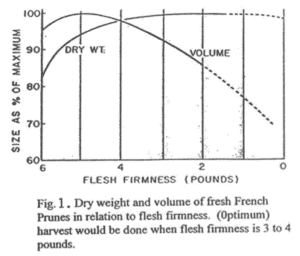
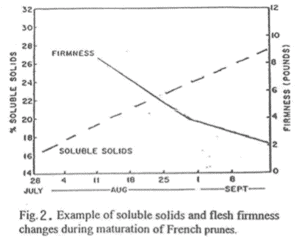
The recommended approach to timing prune harvest is to measure fruit pressure once a week beginning once the fruit skin first shows purple at the suture. Fruit pressure generally drops 1.5 pounds pressure (faster rate in cool weather, slower rate in hot weather) and sugars increase around 2% per week (Figure 2). The following are UC recommended steps to measuring prune fruit maturity:
- Sample 25 fruit from the block, sampling five fruit from five trees. Take fruit from the inside and outside of the canopy. Flag the trees so that the same trees will be used from week to week.
- Slice the skin off the fruit “cheeks” on both sides of each fruit. Just remove the skin, take as little flesh off as possible.
- Measure fruit firmness on each cheek using a “fruit pressure tester” with a 5.16” tip. Fruit pressure testers cost around $300/each.
- Calculate the average pressures per fruit, and record that number. Then calculate the average fruit pressure for the block. Use the average fruit pressure to determine harvest timing but watch for very low pressures that might indicate early drop of some fruit.
- Track fruit pressure each week to determine harvest timing.
- PRUNES ARE MATURE BETWEEN 3-4 POUNDS PRESSURE.
Field sizing. As average fruit pressure reaches 4 lbs, estimate average dry fruit size to help make field sizing plans. Running a 15/16th field sizer helps eliminate damaged fruit and garbage from the bins, but using a larger sizer could be helpful to eliminate smaller, low value fruit in some orchards this year.
The first step in deciding on a field sizer chain size is estimating average fruit size using fresh fruit count per pound, fresh fruit sugar levels and a chart (the Claypool Table, see below), developed by UC researchers. This table is not perfect and tends to predict larger average dry fruit size for lower sugar values. As long as growers are aware of this bias in the Claypool Table, it can be effectively used. The following is a sampling program to estimate average dry fruit size in an orchard suggested by Bill Olson (UCCE Farm Advisor, Butte Co, retired) in a 1999 newsletter.
- At the beginning of harvest, take several100 fruit samples from each orchard. Each sample = 100 fruit (20 fruits from each of 5 trees being sure to sample both fruit clusters inside and outside of the tree at eye level).
- Weigh each fresh sample.
- Divide the number of fruit in each sample (100) by the weight of the sample (in lbs) to determine number of fresh fruit per pound.
- Determine percent soluble solids (a good way is to puree halves of all fruit from a sample in a blender and filter drops of juice through cheesecloth onto a refractometer). Ask your field man or dryer to help if you do not own a refractometer.
- Average the fresh count and soluble solids values for all samples to determine the orchard average. Different areas in the orchard could be treated separately if differences in crop exist that may require different harvest strategies.
- Use the Claypool Table to predict your dry count/lb based on your average fresh count/lb and soluble solids for the orchard.
This sampling protocol can also be used to 1) estimate dry fruit size in the bins as harvest begins, to see if a larger sizer is needed and/or 2) check dropped fruit size to help decide if the sizer used is doing the job needed based on the orchard situation and packer information.
When thinking about targeted fruit size, remember to account for reduction in fruit firmness and an increase in fruit sugar (dry weight size) as the harvest season progresses. The perfect sizing chain size at that start of harvest may be too big a week or two into harvest as fruit softens and sugars increase.
Taking the time to track fruit maturity and sugars, plus estimating dry fruit size once the fruit reaches 4 lbs pressure will pay off in the best possible per acre grower returns.
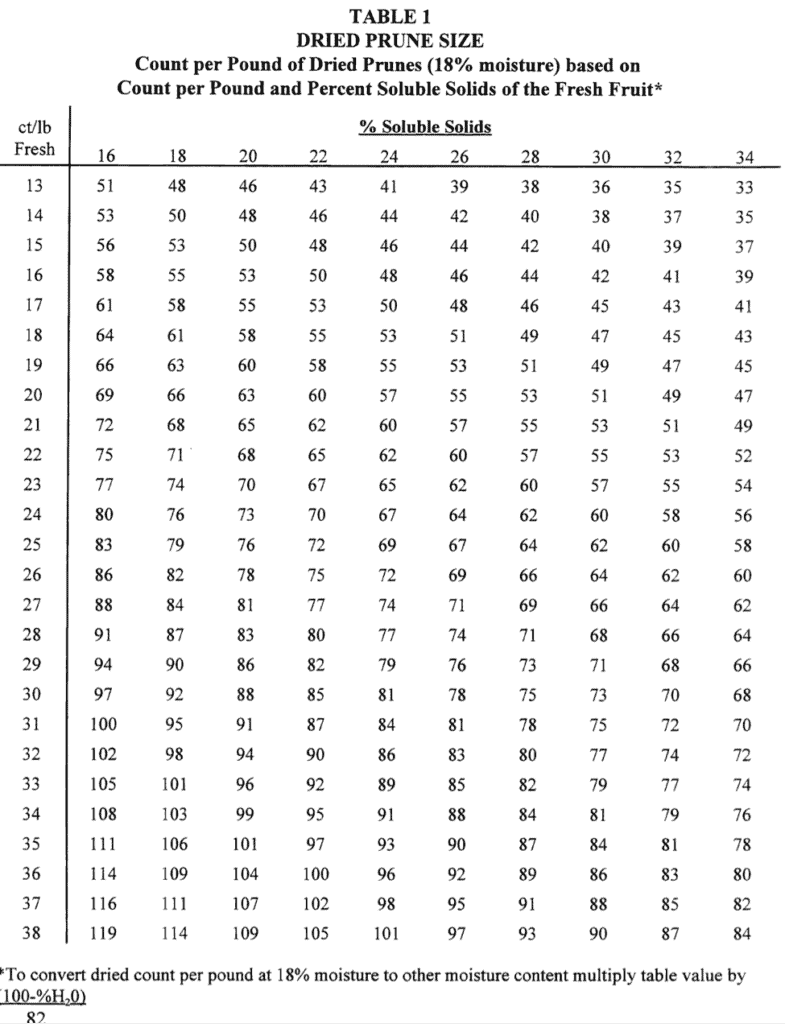
Table 1. The “Claypool Table” developed by Dr. L.L. Claypool,UC Davis in the 1950’s. Recent research shows that this table can overestimate dry fruit size by an average of 10% and so should be considered only a guideline in estimating average dry fruit count/lb before harvest.
Allan Fulton, Irrigation/Water Advisor Retires
Allan Fulton retired as Irrigation and Water Resources Advisor in Tehama, Glenn, Colusa, and Shasta Counties on June 29, 2020. Allan worked for UC Cooperative Extension in Tehama, Glenn, Colusa, Shasta, and Kings Counties for 32 years. He has worked in both orchard and field crops focusing on water management tools and practices to achieve competitive production and efficient use of water and nutrients. He has also worked to support local efforts to achieve sustainable groundwater management. In retirement, Allan is helping new UC irrigation scientists establish their field research programs while wrapping up a couple unfinished projects of his own. He plans to spend more time with family and have an opportunity to travel.
Interested in cover crops? Apply to the Seeds for Bees® program now for free seed!
Seeds for Bees® encourages the use of cover crops to increase the density, diversity, and duration of bee forage in California orchards, farms, and vineyards while improving soil health. The seed mixes available through Seeds for Bees are designed to bloom at critical times of the year when natural forage is scarce but managed and native bees are active. Seeds for Bees serves the needs of bees, beekeepers, and growers, increasing the sustainability of pollination and agriculture. Research has shown that colonies in a pollen abundant environment are more populous, stronger, communicate better, and are more resistant to disease compared to a pollen limited environment.
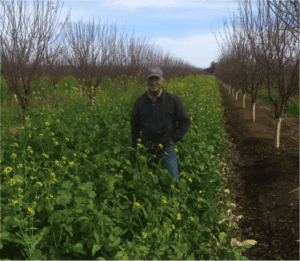
The Pam Mustard Mix in a prune orchard in January.
Pollinator supportive plantings amend and improve soil. Cover crops planted in orchards have a positive impact on the health and workability of the soil. Bee forage cover crops will:
- Increase organic matter
- Increase water infiltration and water availability
- Suppress weeds
- Prevent erosion
- Increase nitrogen
- Attract beneficial insects (IPM)
If accepted, growers receive up to $2,000 worth of free seed their first year of signing up and $1,000 their second year. Apply today and learn more at: www.ProjectApism.org/Seeds-For-Bees.
Questions?
Billy@ProjectApism.org
916-287-3035, Ext. 1
Prunes in the News
- Donn Zea has been appointed to a second term on the USDA Fruits & Vegetables Industry Advisory Committee giving dried fruits from California a louder voice for the industry.
- AgNet West interviewed Donn Zea about CPB’s recent authorization for continuation and the latest crop forecast.
- The Packer reported on the crop forecast for the upcoming harvest.
- Produce for Better Health launched a ‘Roots of our Food’ campaign to spotlight growers and featured Dan and Matt Bozzo with imagery shot this past bloom.
Kids or Grandkids Stuck at Home this Summer?
Between canceled summer camps and closed kid activities, it’s a great time to engage with the kiddos in your life and teach them all about the delicious fruit you grow! The “For Kids” section on CaliforniaPrunes.org just received a mini makeover with the addition of a prune coloring sheet and an updated educational fact sheet, designed in collaboration with the California Foundation for Agriculture for students and educators. Download both for the kids in your life or pass along the link to your favorite teacher.
[View California Prune Activities for Kids]